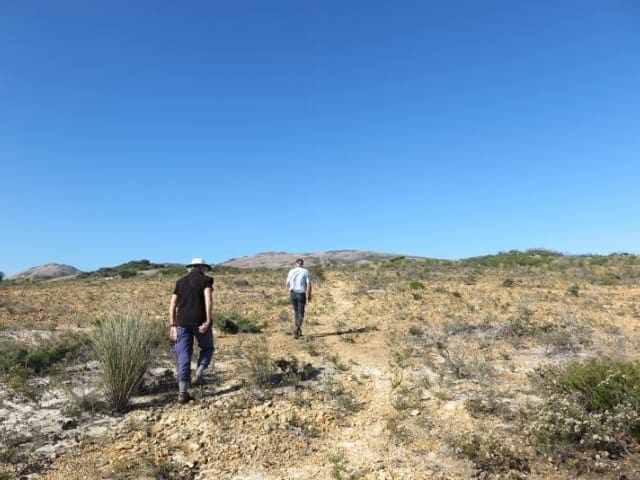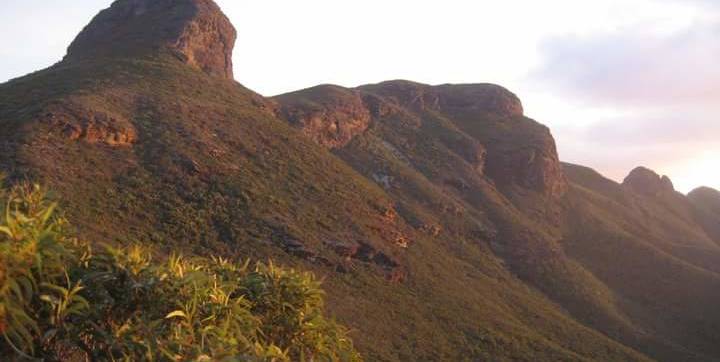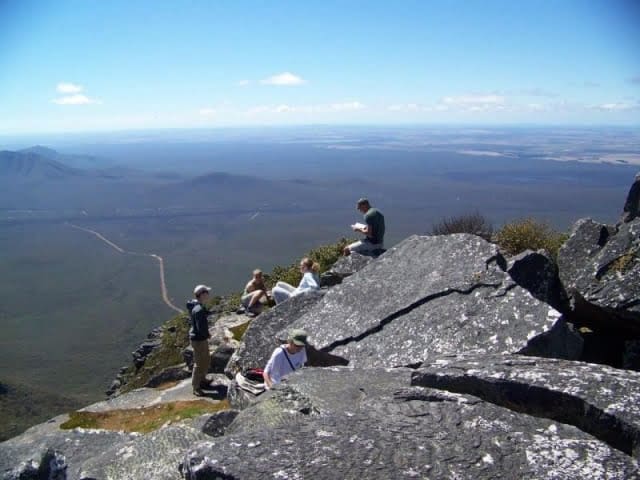Hike at a Glance
Max elevation: 0m
Min elevation: 0m
Total Ascent: 0m
Hike overview
Mount Ragged Walk Trail at Cape Arid National Park is an exciting three kilometre return walk and climbing trail to the Tower Peak of Mount Ragged.
Start the walk trail at the Mount Ragged Car Park and ascend the range to Mount Ragged (Tower Peak). The walk to the summit of Tower Peak (594 metres) is a tough, steep ascent with the track overgrown in parts. Hoist yourself up some decent size rock faces and enjoy the adventure to climb within this spectacular scenery. The climb is rewarded with impressive views. Mid way up the mountain, the trail crosses a platform carved by wave action thousands of years ago when the sea level was much higher than present. Similar wave action is thought to have carved the caverns in the granitic hills of the south coast, for example, the hollow through the summit of Frenchman Peak in Cape Le Grand National Park. Although challenging, the Mount Ragged Walk Trail also offers terrific opportunities for spotting Birds. There are known to be around 160 Bird species in Cape Arid National Park, several of which are threatened or endangered. Camping is available at Mount Ragged, providing toilet and barbecue facilities. Campsites are not bookable and operate on a first come first served basis. Approx 850km from Perth the trail is accessible by 4WD only. From Balladonia on the Eyre Highway there is reasonable gravel road for the first 60km before changing to a rough, rocky sand track.
Tips
Start Point: Mount Ragged Car Park, which is approximately 130 km south of Eyre Hwy (Balladonia Roadhouse)
End Point: Mount Ragged Car Park, which is approximately 130 km south of Eyre Hwy (Balladonia Roadhouse)
Region: Cape Arid National Park, Golden Outback
For more information, a location map and GPS file please visit Trails WA.
Gallery
Got some great shots from this hike? Upload your photos here to inspire others and show off the beauty of the trail!
Click to view form >>
Submitting your photos doesn’t mean you lose ownership. You can be credited for your contributions, and you can request removal at any time.
Content use
Please don’t copy GPX files or content from this site to AllTrails or other platforms. Each trail has been personally mapped, documented, and refined to support Australia’s bushwalking and hiking community. While some details come from land managers, every listing reflects significant personal effort. This is a free, community-driven initiative—your respect helps keep it that way.
Walk map and GPX file
It looks like I don’t have a GPX file for this trail yet. If you have one to share, please email it to me! I’ll verify it against official maps before adding it to help other hikers have a safer, easier experience. Thanks for contributing to a better hiking resource.
Getting there
Getting to the trailhead: Cape Arid National Park.
Closest towns to this walk: Cape Le Grand, Condingup, Esperance, Munglinup, Nornalup, Ravensthorpe, Salmon Gums, Salmon Gums Balladonia, Scaddan Balladonia
About the region
Cape Arid National Park is a wildly beautiful and biodiverse area. Coastal sandheaths, mallee and low granite hills extend inland to Mount Ragged after which the vegetation is transformed into woodlands dominated by saltbush and bluebush. The jagged Russell Range, which rises to its highest point at Tower Peak (almost 600m), comprises ancient uplifted quartzite that has the same origins as the Barrens Range in Fitzgerald River National Park.
Similar walks nearby
Looking for more walks in or near Cape Arid National Park? Try these trails with a similar difficulty grade.
Track grade
Grade 5 (Difficult) - Walks for the Most Experienced: Grade 5 represents the most challenging walking tracks on the AWTGS. These are only recommended for very experienced and fit walkers with specialised skills, including navigation and emergency first aid. Tracks are likely to be very rough, very steep, and unmarked. Walks may be more than 20 kilometers. These challenging walks demand a high level of fitness and experience to navigate difficult terrain, significant elevation changes, and potentially unformed paths.
Explore safe
Plan ahead and hike safely! Carry enough water, pack layers for changing conditions, and bring safety gear like a torch, PLB, and reliable communication device. Check official sources for trail updates, closures, and access requirements, and review local weather and bushfire advice. Most importantly, share your plans with someone before you go. Being prepared makes for a safer and more enjoyable hike! Stay Safe, Explore More, and Always #ExploreSafe.
Packing checklists
What you carry in your pack depends on factors like weather, terrain, and your adventure type. Not sure what to bring? My free planning, food, and packing checklists are a great starting point, covering day hikes, overnight trips, and multi-day adventures. Use them to customise your kit and always prioritise safety.
Let someone know
Before heading out, take a moment to fill out your trip intentions form. It’s a quick way to share your hike details with family or friends. If something goes wrong, they can notify emergency services, ensuring a faster response and peace of mind. Stay safe and enjoy your adventure
Suggest an edit
Spotted a change on this trail? Maybe there are new features, the route has shifted, or the trail is permanently closed. Whatever the update, I’d love your input. Your feedback helps fellow hikers stay informed and ensures that our trail info stays fresh and reliable.
Acknowledgement of Country
Trail Hiking Australia acknowledges the Traditional Owners of the lands on which we hike and pay respects to their Elders, past and present, and we acknowledge the First Nations people of other communities who may be here today.







4 Reviews on “Mount Ragged Trail Walk (3km)”
https://www.facebook.com/share/1DfDes5Kr4/